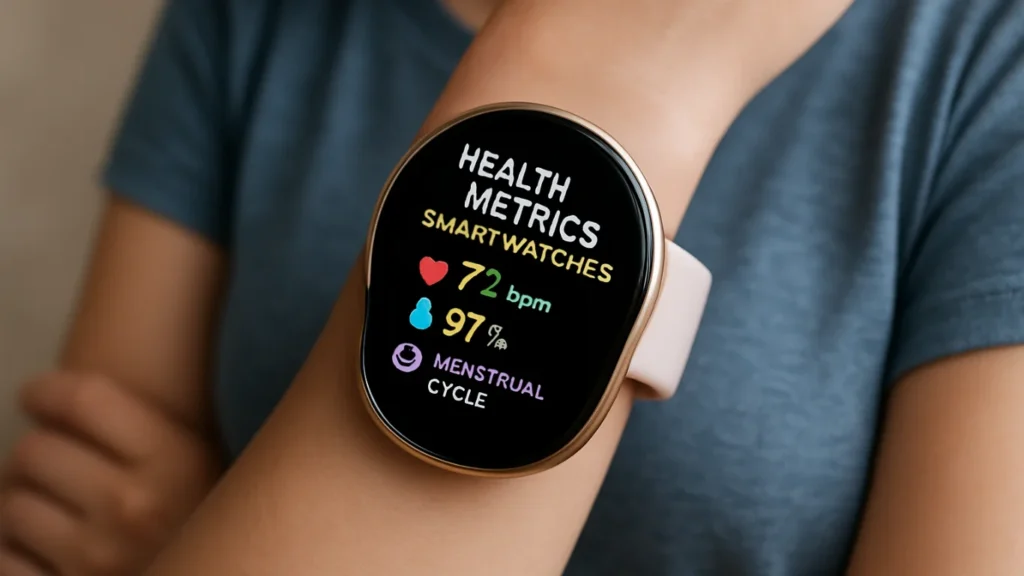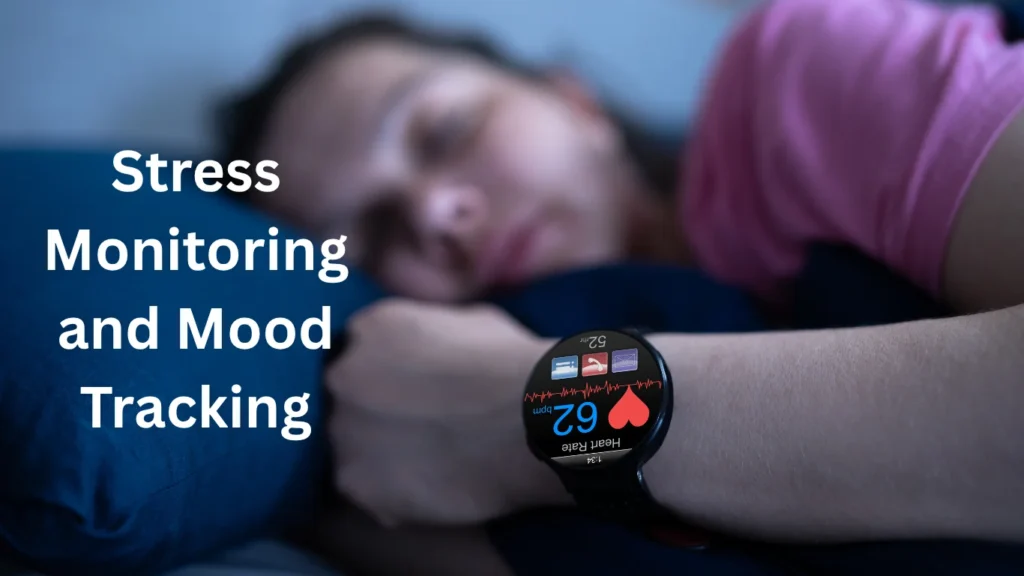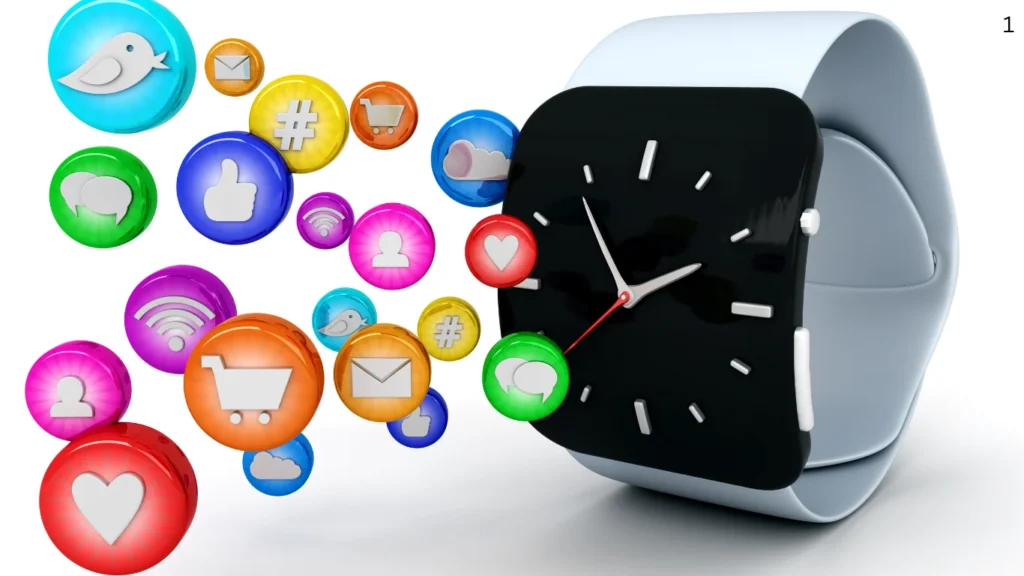
In 2025, women’s smartwatches are no longer just lifestyle gadgets—they have become health companions trusted by millions worldwide. What makes them unique is their ability to track health metrics designed with women’s needs in mind, from heart health and sleep patterns to menstrual cycle insights and stress management.
As someone who has reviewed wearable technology across multiple product generations, I’ve seen first-hand how accuracy and usefulness have improved. For example, the Apple Watch Series 10 now integrates cycle tracking with advanced temperature sensors, while Fitbit Sense 3 provides stress scores that many women use to manage daily routines. These are not experimental features—they are already being used by real women to guide fitness, wellness, and preventive health.
Industry data also backs up this shift. Reports from IDC and Statista show that women now make up a majority of smartwatch buyers in the health-focused wearable segment. Leading brands like Apple, Samsung, and Garmin are not only adding female-specific features but also consulting medical experts to ensure clinical-level accuracy where possible. This signals that women’s health metrics are being taken seriously by the tech industry.
This article will highlight the top health metrics in women’s smartwatches in 2025, explain why they matter, compare devices, and offer tips for making the most of them—so readers can make informed, confident choices.
Understanding Women’s Health Needs in 2025
Women’s health tracking is more than a passing trend—it reflects a deeper understanding of the unique physiological and wellness needs of women. Health metrics such as menstrual cycle tracking, hormonal fluctuations, sleep patterns, stress levels, and heart health are essential for preventive care, lifestyle optimization, and overall well-being.
Medical research confirms that monitoring these metrics can improve outcomes. For instance, irregular heart rates or poor sleep patterns can be early indicators of conditions like arrhythmia or hormonal imbalances. Similarly, tracking menstrual cycles and ovulation helps women plan their fitness routines, manage symptoms, and even monitor fertility. This demonstrates why smartwatches designed with women in mind are more than convenience—they are practical health tools.
Leading wearable brands now include women-specific health features based on clinical studies and collaboration with healthcare professionals. For example, Apple’s Health app integrates cycle tracking with AI insights, Fitbit Sense uses HRV (heart rate variability) to assess stress, and Garmin devices offer advanced sleep analysis. These features empower users with actionable insights, transforming raw data into informed decisions.
By understanding these health needs, women can select devices that provide accurate metrics, relevant recommendations, and personalized guidance. The right smartwatch becomes a trusted partner in daily life, supporting fitness, wellness, and preventive healthcare.
Top Health Metrics in Women’s Smartwatches
In 2025, women’s smartwatches have evolved to track an array of health metrics that go beyond basic fitness. These metrics are designed to provide actionable insights, helping women make informed decisions about their health and wellness. Below are the most important health metrics available in today’s top smartwatches.
1. Heart Rate Monitoring & Heart Rate Variability (HRV)
Heart rate monitoring has long been a staple of smartwatches. In 2025, devices like the Apple Watch Series 10 and Fitbit Sense 3 also measure heart rate variability (HRV), which reflects stress levels, recovery, and overall cardiovascular health. HRV tracking can indicate early signs of fatigue or stress, allowing women to adjust their routines proactively.
2. Menstrual Cycle & Fertility Tracking
Smartwatches now provide detailed menstrual cycle tracking. The Apple Watch integrates temperature-based ovulation predictions, while Garmin Vivosmart 6 logs symptoms and cycle irregularities. These features help women plan workouts, manage symptoms, and monitor fertility.
3. Sleep Tracking & Recovery
Sleep quality is a critical health metric. Devices such as Fitbit Sense 3 and Samsung Galaxy Watch 7 provide deep sleep analysis, REM cycle tracking, and recovery scores. By correlating sleep patterns with stress and activity, women can optimize rest and prevent burnout.
4. Blood Oxygen Monitoring (SpO2)
SpO2 monitoring measures blood oxygen saturation, an essential metric for detecting issues like sleep apnea or respiratory conditions. Many devices, including the Apple Watch and Garmin smartwatches, offer continuous monitoring and alerts for low oxygen levels.

5. Electrocardiogram (ECG)
Some advanced smartwatches, like the Apple Watch Series 10 and Samsung Galaxy Watch 7, provide on-demand ECG readings. This allows early detection of arrhythmias or irregular heart rhythms, supporting proactive healthcare management.
6. Body Temperature Tracking
Temperature tracking, integrated into Oura Ring Horizon and Fitbit devices, helps women monitor hormonal changes, detect potential illness, and track menstrual cycle variations.
7. Blood Pressure Monitoring
Select devices like Samsung Galaxy Watch 7 offer cuffless blood pressure tracking, helping users manage cardiovascular health conveniently at home.
8. Activity & Fitness Tracking
Step count, calories burned, VO2 Max, and exercise recognition remain essential. Smartwatches like Garmin Vivosmart 6 offer female-focused activity tracking with AI-driven insights tailored to fitness goals and menstrual cycles.

9. Mental Health & Stress Monitoring
AI-driven stress monitoring uses HRV, heart rate, and sleep data to assess mental wellness. Devices like Fitbit Sense 3 provide stress scores and guided breathing exercises, helping women manage mental health effectively.
10. Pregnancy & Postpartum Health Metrics
Emerging features in devices such as Oura Ring and Apple Watch allow tracking of pregnancy-related metrics, including heart rate trends, sleep quality, and recovery post-delivery. These features offer valuable guidance for expectant and new mothers.
The combination of these metrics transforms smartwatches from simple fitness trackers into comprehensive health management tools for women in 2025. Users gain insights into cardiovascular health, sleep, fertility, mental well-being, and more, empowering them to make data-driven decisions for wellness and preventive care.
Why These Metrics Matter for Women?

Understanding health metrics is one thing, but knowing why they matter in daily life is where smartwatches provide real value. In 2025, women’s smartwatches are not just tracking numbers—they are delivering actionable insights that support wellness, preventive care, and lifestyle optimization.
1. Cardiovascular Health
Heart rate monitoring and ECG tracking allow women to detect irregularities early. For instance, persistent high resting heart rates or arrhythmias can indicate underlying conditions. Using smartwatches like Apple Watch Series 10 or Samsung Galaxy Watch 7, women can share real-time data with their healthcare providers, improving early detection and intervention.
2. Menstrual and Fertility Insights
Cycle tracking is more than just recording dates. By monitoring temperature, HRV, and symptoms, women gain insights into hormonal patterns, ovulation, and fertility. Fitness routines, nutritional adjustments, and family planning decisions can all be informed by this data. Brands like Garmin Vivosmart 6 and Fitbit Sense 3 provide evidence-based guidance, reflecting expert-backed design.
3. Sleep and Recovery
Sleep quality directly affects energy levels, mental health, and overall wellness. Devices that analyze deep sleep, REM cycles, and recovery scores help women adjust routines and manage stress. Poor sleep patterns detected over weeks can prompt lifestyle changes or medical consultations, making the metrics practically useful.
4. Stress and Mental Wellbeing
AI-driven stress tracking evaluates HRV, heart rate, and sleep data. By alerting users to high stress or low recovery, smartwatches enable proactive management strategies, including guided breathing exercises or mindfulness reminders. This is particularly important for women balancing work, family, and personal wellness.
5. Pregnancy and Postpartum Monitoring
Tracking health metrics during pregnancy helps monitor maternal and fetal wellbeing. Features like heart rate trends, sleep analysis, and recovery tracking postpartum allow women to make informed decisions, supporting safe, healthy outcomes.
Women’s health metrics in smartwatches provide more than raw data—they offer insights that can guide fitness, wellness, preventive care, and family planning. By leveraging these tools, women can take control of their health in real-world, practical ways.
Comparing Top Women’s Smartwatches in 2025
Selecting the right smartwatch in 2025 depends on which health metrics matter most and how accurately the device tracks them. Here’s a comparison of some of the best women-focused smartwatches currently available:
1. Apple Watch Series 10
- Strengths: Advanced heart rate monitoring, ECG, blood oxygen (SpO2), cycle tracking, and pregnancy/postpartum insights.
- Unique Feature: AI-powered health recommendations and seamless integration with Apple Health.
- Why it matters: Ideal for women seeking comprehensive health tracking and clinical-grade accuracy.
2. Fitbit Sense 3
- Strengths: Stress monitoring with HRV, sleep tracking, temperature trend insights, and menstrual cycle tracking.
- Unique Feature: EDA sensor for real-time stress analysis.
- Why it matters: Excellent for women focusing on stress management and wellness optimization.
3. Garmin Vivosmart 6
- Strengths: Activity-focused metrics, sleep and recovery tracking, menstrual cycle monitoring, and VO2 Max.
- Unique Feature: Female-specific health insights with activity optimization.
- Why it matters: Best for fitness-oriented women who want actionable health and activity data.
4. Samsung Galaxy Watch 7
- Strengths: ECG, SpO2, blood pressure tracking, cycle tracking, and sleep monitoring.
- Unique Feature: Large display with advanced health apps for female users.
- Why it matters: A well-rounded smartwatch for women who want health tracking combined with a premium display and interface.
5. Oura Ring Horizon
- Strengths: Sleep quality, temperature tracking, heart rate, and advanced readiness scores.
- Unique Feature: Compact ring form-factor for continuous monitoring.
- Why it matters: Best for women who prefer a discreet wearable while still tracking essential health metrics.
No single smartwatch is perfect for every woman. The Apple Watch Series 10 excels in medical-grade monitoring, Fitbit Sense 3 shines in stress and wellness tracking, and Garmin Vivosmart 6 is ideal for fitness optimization. Understanding your personal health priorities ensures that you choose a device that truly enhances daily wellbeing.
Tips for Getting the Most from Your Smartwatch
Owning a women’s smartwatch is just the first step; maximizing its benefits requires understanding how to use it effectively. Here are practical tips for making the most of your device in 2025:
1. Wear It Correctly
For accurate heart rate, SpO2, and ECG readings, ensure your smartwatch is snug but comfortable on your wrist or finger (for rings). Avoid loose straps, which can cause inconsistent data.
2. Sync with Health Apps
Integrate your smartwatch with trusted health apps like Apple Health, Google Fit, or Fitbit Premium. This allows consolidated data analysis, personalized insights, and trend tracking over time.
3. Calibrate and Update Regularly
Regularly update your smartwatch’s firmware to benefit from new health features and improved sensor accuracy. Some devices also require calibration for specific sensors, like blood pressure or SpO2, to ensure reliability.
4. Track Trends, Not Just Daily Numbers
Health metrics are most valuable when analyzed over weeks or months. Look for trends in heart rate, sleep, and stress, rather than focusing on single-day anomalies.
5. Personalize Alerts and Notifications
Set reminders for hydration, activity breaks, or stress management. Many smartwatches offer AI-driven recommendations tailored to your routines, menstrual cycle, or fitness goals.
6. Protect Your Data
Women’s health data is sensitive. Use strong passwords, app permissions, and encryption features to maintain privacy. Check privacy policies of apps and devices for transparency.
7. Consult Healthcare Professionals
While smartwatches provide valuable insights, they are not a replacement for medical advice. Share data with doctors when monitoring conditions like arrhythmias, sleep disorders, or hormonal imbalances.
By wearing the device correctly, syncing with apps, tracking trends, personalizing settings, and maintaining privacy, women can fully leverage smartwatches as actionable health tools. Proper usage enhances accuracy, reliability, and the overall value of the metrics provided.
Future of Women’s Health Metrics in Smartwatches
The future of women’s smartwatches in 2025 and beyond is poised to become even more personalized, proactive, and medically relevant. Advances in artificial intelligence (AI), machine learning, and sensor technology are transforming wearables from passive trackers into intelligent health companions.
1. AI-Driven Health Insights
Next-generation devices are expected to leverage AI to provide predictive health alerts, such as detecting early signs of arrhythmia, hormonal imbalances, or stress-related conditions. These insights help women take preventive actions before serious issues arise.
2. Integration with Healthcare Providers
Smartwatches will increasingly sync securely with electronic health records (EHRs), allowing doctors to monitor patient metrics remotely. This integration ensures that wearable data is clinically actionable, improving preventive care and chronic condition management.
3. Enhanced Pregnancy and Postpartum Tracking
Future devices will provide more granular pregnancy monitoring, including fetal heart rate trends, postpartum recovery guidance, and AI-driven nutritional and activity recommendations.
4. Non-Invasive Metrics & Continuous Monitoring
Advancements in cuffless blood pressure, continuous glucose monitoring, and hydration tracking will allow women to monitor critical health parameters seamlessly without intrusive devices.
5. Personalized Wellness Ecosystems
Smartwatches will act as central hubs, connecting smart home devices, AI coaches, and wellness apps. This creates a holistic ecosystem where women can manage fitness, mental health, sleep, and nutrition through personalized, data-driven recommendations.
The future of women’s smartwatches promises smarter, more predictive, and personalized health insights. By integrating AI, medical data, and lifestyle management, these devices will empower women to make better-informed decisions about their health and wellness.
Frequently Asked Questions (FAQ)
Q1. Are smartwatches accurate for women’s health tracking?
Modern smartwatches use advanced sensors and algorithms that offer high accuracy for most daily health metrics in women’s smartwatches. However, they should not replace clinical testing.
Q2. Can smartwatches predict ovulation correctly?
Yes, many 2025 smartwatches use temperature, heart rate, and cycle history to estimate ovulation with increasing accuracy.
Q3. Is ECG safe to use daily on a smartwatch?
Yes. It’s safe, non-invasive, and offers valuable insight if used regularly to monitor rhythm or abnormalities.
Q4. What is a good resting heart rate for women?
A typical resting heart rate ranges from 60 to 100 BPM. Active women may have lower readings.
Q5. Can smartwatches help with mental health?
Yes. With stress tracking, mood journaling, and breathing exercises, many smartwatches help users manage stress and anxiety.
Conclusion:
Women’s smartwatches in 2025 have evolved into powerful health companions, offering insights far beyond basic fitness tracking. From heart rate and ECG monitoring to menstrual cycle tracking, sleep analysis, and stress management, these devices provide actionable data that empowers women to make informed decisions about their wellness.
By understanding the significance of these health metrics, women can select a smartwatch that aligns with their personal health priorities, whether that’s managing stress, optimizing fitness, tracking pregnancy, or monitoring cardiovascular health. Leading devices such as Apple Watch Series 10, Fitbit Sense 3, Garmin Vivosmart 6, Samsung Galaxy Watch 7, and Oura Ring Horizon showcase the range of capabilities available, each catering to different wellness needs.
The future promises even greater integration of AI-driven insights, predictive health alerts, and personalized wellness ecosystems, making smartwatches indispensable tools for women seeking proactive health management. While these devices are supplementary to professional medical care, they provide a reliable and trustworthy way to monitor and improve daily health.
Ultimately, investing in a women-focused smartwatch in 2025 is not just about tracking metrics—it’s about empowering women with knowledge, control, and confidence over their health and wellbeing.
Read more: Edge AI Devices: The Future of On-Device Intelligence in 2025 and Beyond
Read more: The Role of Edge AI in Healthcare Monitoring: Smarter, Safer, and Faster Patient Care
Anurag Ghosh is the founder of Tech Fashion USA, a website dedicated to bringing readers the latest trends in electronics, gadgets, AI innovations, and smart tech. With a passion for simplifying complex technology, Anurag curates well-researched, easy-to-understand articles that help consumers make smarter buying decisions. Whether you’re exploring the future of wearable tech or comparing the best AI-powered gadgets, Anurag’s insights are always grounded, practical, and focused on what truly matters to everyday users. Follow his work for unbiased reviews, breaking tech news, and expert buying guides.
